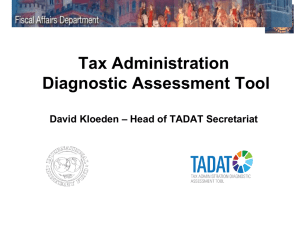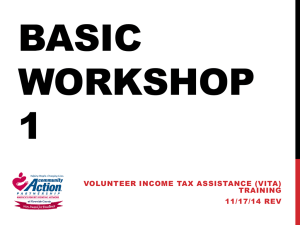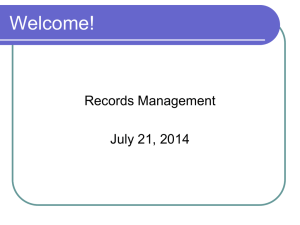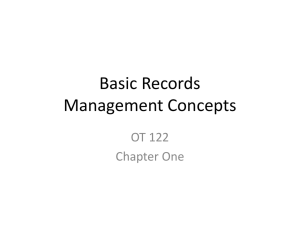Summer 2014 Newsletter
advertisement
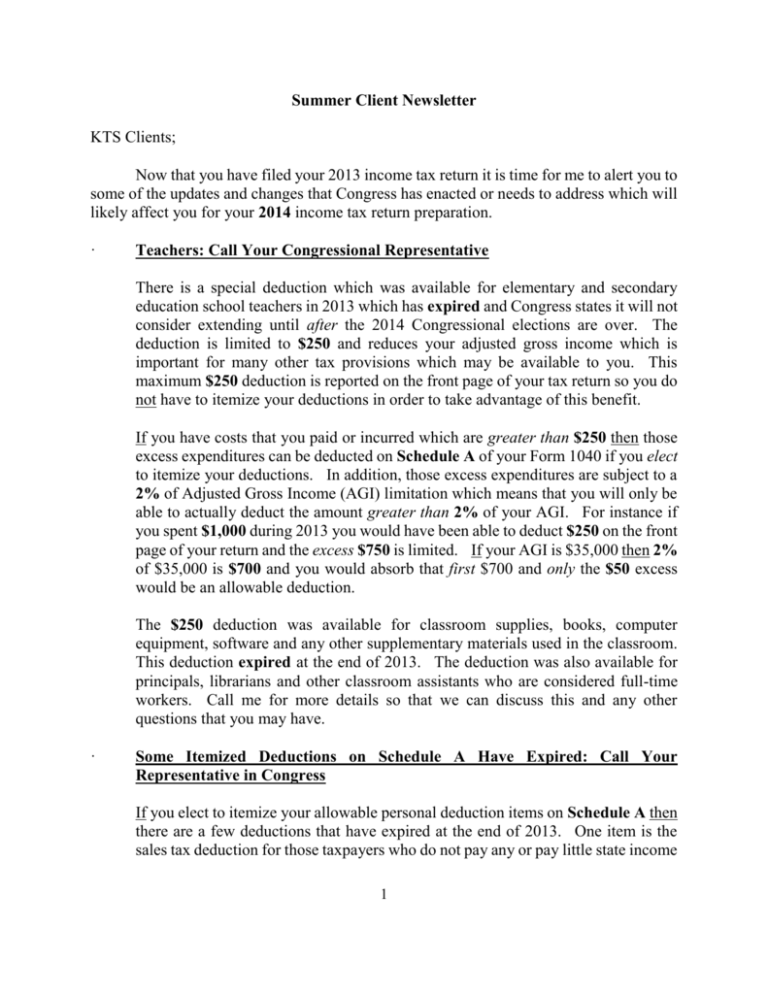
Summer Client Newsletter KTS Clients; Now that you have filed your 2013 income tax return it is time for me to alert you to some of the updates and changes that Congress has enacted or needs to address which will likely affect you for your 2014 income tax return preparation. · Teachers: Call Your Congressional Representative There is a special deduction which was available for elementary and secondary education school teachers in 2013 which has expired and Congress states it will not consider extending until after the 2014 Congressional elections are over. The deduction is limited to $250 and reduces your adjusted gross income which is important for many other tax provisions which may be available to you. This maximum $250 deduction is reported on the front page of your tax return so you do not have to itemize your deductions in order to take advantage of this benefit. If you have costs that you paid or incurred which are greater than $250 then those excess expenditures can be deducted on Schedule A of your Form 1040 if you elect to itemize your deductions. In addition, those excess expenditures are subject to a 2% of Adjusted Gross Income (AGI) limitation which means that you will only be able to actually deduct the amount greater than 2% of your AGI. For instance if you spent $1,000 during 2013 you would have been able to deduct $250 on the front page of your return and the excess $750 is limited. If your AGI is $35,000 then 2% of $35,000 is $700 and you would absorb that first $700 and only the $50 excess would be an allowable deduction. The $250 deduction was available for classroom supplies, books, computer equipment, software and any other supplementary materials used in the classroom. This deduction expired at the end of 2013. The deduction was also available for principals, librarians and other classroom assistants who are considered full-time workers. Call me for more details so that we can discuss this and any other questions that you may have. · Some Itemized Deductions on Schedule A Have Expired: Call Your Representative in Congress If you elect to itemize your allowable personal deduction items on Schedule A then there are a few deductions that have expired at the end of 2013. One item is the sales tax deduction for those taxpayers who do not pay any or pay little state income 1 taxes. Therefore, based on Tables established by the IRS you may be able to deduct the sales taxes paid on your consumption of goods and services. In addition to the Standard Table amounts you can also deduct the sales tax paid or incurred on big ticket items such as automobiles, boats, building materials, etc. You will need to have your receipts in order to deduct and verify the sales tax deduction. Contact me for more information. The other Schedule A itemized deduction that expired after 2013 is the deduction for Mortgage Insurance Premiums (PMI). If you have a mortgage and are paying PMI then you could be eligible for this deduction. The deduction does have a phase-out provision once your Adjusted Gross Income (AGI) reaches $100,000. It is completely phased out when your AGI reaches $110,000. · Child Tax Credit There is a Child Tax Credit available to qualified taxpayers who have a dependent child under the age of 17 at the close of 2014. The maximum credit is $1,000. The credit is available to a taxpayer based on their filing status and modified Adjusted Gross Income. The credit is phased out as income rises. For a single taxpayer with one qualifying child the phase-out begins at $75,000 and is completely gone at $94,001. It is the same range for those taxpayers with a filing status of Head of Household. For taxpayers filing a married joint return the phase-out for one qualifying child is from $110,000 - $129,001 and for a filing status of married filing separately it is half of that of at $55,000 - $74,001. Give me a call so we can discuss in further detail. · Some Education Benefits Still Alive But One Has Expired: Contact Your Congressional Representative Congress extended a few tax benefits that will help you if you are paying for post high school education expenses. These benefits come in the form of a credit. A credit is an item which reduces your actual tax. The American Opportunity Credit is still available for those taxpayers who have a modified adjusted gross income below a specified threshold amount depending on their filing status. The credit can be as high as $2,500 for each of the taxpayer’s qualifying students. A qualifying student could be the taxpayer, the spouse or a dependent child of the taxpayer. The $2,500 maximum credit is available for a married couple filing a joint return who has a modified AGI of less than $160,000. The $2,500 amount is reduced as the income grows to $180,000. After that level it 2 is completely phased out. If you are a taxpayer whose filing status is single or head of household then the levels of income are half of those amounts beginning at $80,000 and ending at $90,000. A taxpayer who files as married filing separately cannot take advantage of the credit. In order to get the full $2,500 credit the taxpayer must pay a total of $4,000 in qualifying tuition, fees and required course materials. The first $2,000 qualifies for a 100% credit therefore $2,000 and the second $2,000 qualifies for a 25% credit which would be $500. This is especially attractive for those taxpayers who may be attending a community college where the tuition and fees are generally less expensive than those at a 4 year university. The credit is available for the first 4 years of post-high school education. The provision has been extended through 2017. Contact me to discuss your needs. · Another education benefit that Congress has renewed is the deduction for Student Loan Interest. It is available even if you do not elect to itemize your deductions on Schedule A. The maximum deduction is $2,500 per year. It is available to all taxpayers except those with a filing status of married filing separately. There is a modified adjusted gross income test which begins at $65,000 and ends at $80,000 for a filing status of single and head of household and for a married couple filing a joint return it begins at $130,000 and ends at $160,000. The important issue to be aware of is that no matter what the filing status is on your return the maximum deduction is always only $2,500. If two single people file their returns then each is eligible for the maximum $2,500. However, if those two single people were to marry and file a joint return then there is only one $2,500 deduction. And remember if they file married separately then they get no deduction. Contact me for more details. · There is another education benefit that expired at the end of 2013 that we are waiting for Congress to extend for 2014 and beyond. The benefit is the deduction for “qualified higher education expenses” which is also available for those taxpayers who do not itemize deductions on Schedule A. This benefit would be available for each qualifying student on the tax return. The deduction could be $2,000 based on your modified AGI or $4,000 if your modified AGI is lower than a specified threshold amount based again on your filing status. If your filing status is single or head of household and your income is $65,000 or less then you could be eligible for a $4,000 deduction. If your income is greater than $65,000, but is not greater than $80,000 then you would be eligible for a $2,000 deduction. Any amount greater than $80,000 disqualifies you from the deduction. For a married couple filing a joint return the $4,000 deduction is available if your income is less than $130,000. If it is more than $130,000 but not more than $160,000 then you would be eligible for the $2,000 deduction. If you are married but file separately from your spouse then the deduction is not available to either of you. 3 · Consider Making IRA Contributions Contributions to an Individual Retirement Account (IRA) are a good way to save for your future. The maximum contribution for 2014 is $5,500. Anyone who has “earned income” such as wages, salary and self-employment is eligible to make the IRA contribution. The taxpayer with a modified AGI below specified thresholds based on their filing status has the opportunity to deduct their contributions therefore paying less tax in the current year. Again the ability to deduct your IRA contribution is based on levels of income. For a married couple filing a joint return if your income is less than $96,000 then you can deduct $5,500 in full for both you and your spouse even if only one of you has earned income. Therefore with a minimum of $11,000 of total earned income you could deduct it in full. As your modified AGI increases up to $116,000 you begin to lose the ability to deduct the contribution. However, the excess amount can be contributed to a Roth IRA which is a non-deductible contribution but the growth will never be included in your gross income when you take a future distribution. Call me about the details of contributions and distributions of a Roth IRA and by the way if you are age 50 or greater on the last day of the tax year then you can contribute an additional $1,000 for what is called the “catch up” contribution. For taxpayers whose filing status is single or head of household you are eligible for a $5,500 deductible IRA when your modified AGI is $60,000 or less. When you have an income in excess of $70,000 you can no longer make a deductible IRA. Between $60,000 and $70,000 the $5,500 is phased out but again you should contact me about the benefits of a Roth IRA contribution. There is a special rule only for married couples who file a joint return where one spouse either does not have any earned income or has earned income but is not eligible to participate in an employer’s pension plan. If this is your situation then for 2014 you can have a $5,500 deductible IRA contribution when your joint modified AGI is $181,000 or less. The $5,500 maximum deductible contribution decreases as your income grows between $181,000 and $191,000. And again if you and/or your spouse is age 50 or older on the last day of the tax year then you can contribute an additional $1,000 for each qualifying spouse for the “catch up” contribution. · Health Care Legislation Issues 2013 began the era of the new additional Medicare tax on wages and self-employment income of specified taxpayers based on their filing status and level 4 of wages. Many taxpayers will not be affected by the imposition of this new tax but those who are or will be in the future need to be aware of the changes. A new additional Medicare tax of .9% was imposed on wages in excess of certain amounts. A single taxpayer including those with a filing status of head of household will have the tax assessed against them on wages greater than $200,000. For a married couple filing a joint return that amount is $250,000 and for those with a filing status of married filing separately the amount is half of that at $125,000. As an example, if a taxpayer who is single has wages of $225,000 which is $25,000 over the threshold amount of $200,000 then that excess $25,000 would have an additional tax of $225. If that taxpayer was married and filed a joint return with the spouse then there would not be an additional tax imposed because the threshold amount for a married couple begins at $250,000. However, if the taxpayer earned $225,000 and files a return separate from the spouse then the excess amount would be $100,000 since the threshold is half that of filing joint, which is $125,000 as a result the additional Medicare tax would be $900 which is .9% of $100,000. This would be the same result for a taxpayer who is self-employed. Call me soon to discuss your situation. There may be a need for you to either increase your withholding or increase your quarterly estimated tax payments. Note that employers are not required to withhold the additional tax until the employee’s Medicare wages actually exceed $200,000 no matter what your filing status may be when you actually file the return. · In addition to the new Medicare tax on wages and self-employment income, there is also an additional Medicare tax of 3.8% being assessed on what is called “net investment income” of specified taxpayers based again on the filing status. The 3.8% tax will be assessed on the lesser of a taxpayer’s “net investment income” or the excess of (if any) of the taxpayer’s modified AGI greater than a specified threshold amount. The threshold amounts are again based on filing status and fortunately are the same thresholds as we saw for wages and self-employment income of $200,000 for single and head of household, $250,000 for married filing joint and $125,000 for married separate. For example, if you are single and you have net investment income of $1,000 and your modified AGI was $250,000 then your additional tax would be 3.8% of the lesser of $1,000 or 3.8% of the excess of $50,000 ($250,000 - $200,000). Therefore, you would pay an additional Medicare tax of $380. If you were married filing a joint return then you would not have an additional tax because the threshold would be $250,000 and there would be no excess (3.8% x $0 - $0). However, if you were married filing a separate return then your excess would be $125,000 and you would pay 3.8% of the lesser of the excess $125,000 or 3.8% of the $10,000 which would still result in $380. 5 For this purpose “net investment income” includes the gross income from taxable interest, all dividends, annuities, royalties, rentals, income from passive activity and gain from the disposition of non-business property. From the gross income you will subtract all expenses related to these items of income. Contact me so that we can discuss the major details of this change. Your investment income will not include any distributions from pension plans of any kind including IRAs and it will not include any item which is not included in gross income for federal income tax purposes. Therefore, municipal bond interest is not included and the excluded gain from the sale of your principal residence is not included. Also there is a major change which began in 2013 for the ability to deduct medical expenses on Schedule A. Prior to 2013 a taxpayer had to reach a 7.5% floor amount before the first dollar of medical expenses could be deducted. As an example, if the taxpayer had an Adjusted Gross Income (AGI) of $100,000 in 2012 then the taxpayer would absorb the first $7,500 of eligible medical costs before they could deduct the first $1. Therefore, if they incurred $10,000 of medical costs not covered by insurance or reimbursed then they would have an allowable deduction of $2,500. However, beginning in 2013 the floor was increased to 10% so there would be no excess amount which could be deducted. · More on Health Care In March of 2010 Congress passed health care legislation which has become known as the “Affordable Care Act” or ACA. For purposes of filing your 2014 tax returns and beyond you may be eligible for a new refundable credit called the “Premium Assistance Credit” (PAC). You are eligible if you have obtained your insurance coverage through the government’s “market place” or American Health Benefits Exchange. Each state was required to establish an exchange no later than January 1, 2014. For those states that did not do so, there is a Federal Exchange through which insurance can be obtained. The credit is available if the insurance you obtained meets the requirements of “minimal essential coverage” as provided in the legislation. About 8 million individuals have acquired insurance coverage through the Exchanges and about 6.7 million are eligible for the premium assistance credit and you may be one of them. The credit is based on your modified adjusted gross income which will be determined when we prepare your 2014 federal income tax return in 2015. If you are eligible for the credit then you may have already benefitted by it in the form of an “advanced” PAC where the government has paid a portion of your monthly premiums directly to the insurance provider. In order to determine whether you will receive additional credit or have to give some of the credit back because your income actually increased over what was reported when 6 you applied for the coverage, there will be a reconciliation calculation at the time we prepare your return. Even if you are not eligible for the PAC everyone is required to have health insurance coverage beginning January 1, 2014 and there could be a penalty imposed for not having coverage. Even if you have coverage you will need to report that fact on your 2014 Form 1040 and we will be required to fill out extra forms with your return as a result of this new legislation. Your insurance provider will be sending you a required government report which you will need to provide to us in order to properly prepare your return. · Tax Rate Issues Congress and the President have come to an agreement on the rate structure for the 2014 income tax rates and were able to agree to continue the 10% income tax bracket which was supposed to have expired. In addition, there was much controversy about restoring the 36% and 39.6% brackets which were instituted during the Clinton Administration and temporarily set aside during the Bush Administration. Most taxpayers were not impacted by any change in tax rates in force because the graduated rate structure of 10%, 15%, 25%, 28%, 33% and 35% are still here. The 36% bracket was not restored but the 39.6% was restored and the table below illustrates the impact during 2014 based on filing status. Taxable income where the 39.6% rate is assessed: Filing Status Single Head of Household Married Joint Married Separate Amount > > > > $406,750 $432,200 $457,600 $228,800 7 Also the following chart shows all of the tax brackets for 2014. 2014 Taxable Incomes and Bracket Threshold Limits Filing Status 10% Single 15% 25% 28% 33% 35% $9,075 $36,900 $89,350 $186,350 $405,100 $406,750 Head of Household $12,950 $49,400 $127,550 $206,600 $405,100 $432,200 Married Joint & Surviving Spouse $18,150 $73,800 $148,850 $226,850 $405,100 $457,600 $9,075 $36,900 $74,425 $113,425 $202,550 $228,800 $2,500 $5,800 $8,900 $12,150 Married Separate Estates & Trust $-0- In addition, the “long-term capital gain” rate has been left intact at 15% except for those taxpayers who are in the 39.6% bracket. Those taxpayers will be taxed at a 20% long-term capital gain rate. For those same individuals in the 39.6% bracket if they have excess “qualified dividend” income in 2014 then the excess also is taxed at 20%. Note: Trust and Estate will no longer have a 35% bracket. It is replaced by 39.6%. Also, there is no 10% bracket for Trusts and Estates. · Phase-out of Itemized Deductions and Personal Exemptions For 2014 every taxpayer will be eligible for a personal exemption and a dependency exemption of $3,950 for each qualifying dependent. However, certain taxpayers based on their filing status with an AGI greater than a specified threshold amount will begin to lose the benefit of those exemptions according to the schedule below: 8 Filing Status AGI Threshold Married Couples & Surviving Spouses $305,050 Head of Household $279,650 Single $254,200 Married Separate $152,525 Once the taxpayer is beyond the phase-out level no exemptions are allowable. As a result the taxpayer is paying an effective rate which is greater than the amounts in the brackets. · For itemized deduction issues on Schedule A the total itemized deductions begin to be phased-out at specified dollar amounts with the excess multiplied by 3%. As a result while specific itemized deductions (such as mortgage interest charitable contributions, etc.) are not disallowed, total itemized deductions are reduced by the phase-out rule. Again the effective rate of tax paid is greater than the rate according to the graduated rate tables. The phase out is based on filing status and is the same AGI test as for the phase-out of exemptions as stated below. Filing Status AGI Threshold Married Couples & Surviving Spouses $305,050 Head of Household $279,650 Single $254,200 Married Separate $152,525 The 2010 Health Care Legislation Known As The Affordable Care Act The 2010 Health Care Legislation known as the Affordable Care Act (ACA) provides that all “applicable individuals” will have to ensure that they are covered under a health insurance policy that provides “minimum essential coverage” beginning January 1, 2014. 9 The coverage must include the taxpayer, spouse and those dependents of the taxpayer claimed for the dependency exemption on their tax returns. If the taxpayer does not have the “minimum essential coverage” in 2014, then a penalty known as a “shared responsibility payment” may be assessed on the 2014 tax return when it is filed in 2015. Some taxpayers will not be assessed the penalty if they satisfy any of the following categories: Qualify for religious conscience exemption which the taxpayer will need to verify Member of a healthcare sharing ministry which will also need to be verified Any month in which the taxpayer is not a US citizen or US national or an alien lawfully present in the US The person is incarcerated other than incarceration pending the disposition of charges In addition to those listed above, there are additional individuals who will not be assessed a penalty because they have coverage under a government sponsored program as follows: Medicare Medicaid CHIP TRICARE for Life program VA Health Care program Peace Corps In addition, the following taxpayers are also deemed to have “minimum essential coverage” and will not be assessed a “shared responsibility payment” (penalty): Those with coverage under an eligible employer-sponsored plan Coverage under a health plan offered in the individual market within a state Coverage under a grandfathered plan which existed prior to enactment of the ACA which has not substantially changed the terms of coverage 10 Any other health benefits coverage such as a state health benefits risk pool, which the Secretary of Health and Human Services with coordination with the IRS recognizes as “minimum essential coverage” There are also some “applicable individuals” who will be provided with an exemption from the requirement to maintain a minimal level of health coverage as follows: Individuals who cannot afford coverage which is defined as a premium payment amount which is greater than 8% of the taxpayer’s household income (e.g., if the taxpayer’s household income was $40,000 and the total annual premium was greater than $3,200 then the taxpayer would be exempt from the required coverage) Taxpayers with income less than the threshold for filing an income tax return (e.g., a single taxpayer will have a personal exemption of $3,950 and a standard deduction of $6,200 totaling $10,150 and $20,300 for a married couple filing a joint return in 2014) Months during “short coverage gaps” which is for taxpayers not covered for a continuous period of 3 months or less (without regard to a calendar year) Members of Indian tribes Hardships as defined by Health and Human Services If the taxpayer is not covered or exempt, then the “shared responsibility payment” (penalty) that will be assessed on the taxpayer’s individual tax return will be the greater of a flat dollar amount or a percentage of the taxpayer’s household income over the threshold for filing a tax return. In 2014, the flat dollar amount is $95 per person up to 3 persons in a family for a total of $295. In 2014, the percentage is 1%. Therefore if a single taxpayer has household income in 2014 of $19,650 or less, the shared responsibility payment will be $95 ($19,650-10,150=$9,500 x 1%=$95). If the amount were $20,650 the payment would be $105 ($20,650-10,150=$10,500 x 1%). The maximum penalty will be no greater than 11 the national average cost of what the law calls a “bronze” plan. For more information, please contact me. 12




